Kangaroo Island: How soldier settlers tamed the bush, then bushfires
The Black Summer bushfires were just the latest in a lifetime of challenges thrown at Kangaroo Island’s soldier settlers
SA Weekend
Don't miss out on the headlines from SA Weekend. Followed categories will be added to My News.
Ivy Wooton thought she’d known this road. For a woman of 97 years, her island country was as familiar as the smell of harvest. But not this day.
The road she’d travelled for more than six decades was now a daunting passage through ashen, smouldering, unrecognisable land; utterly disorientating in its transformation. The endless rows of blackened trees, the acres of scorched earth, the rubble of homes on the horizon; this wasn’t her memory of the place.
It was only after she arrived at the entrance to her scarred Kangaroo Island farm that Ivy saw something she remembered. Its familiarity was as breathtaking as it was surprising. There in spectacular full bloom stood a majestic flowering gum tree, glowing defiant against the dark desolation of its surroundings.
“It was just absolutely beautiful,” Ivy recalls with tears in her eyes.
“It meant so much to see that because my granddaughter and I had planted it years ago. Our neighbour who was helping to fight the fire knew about its history. He said ‘I won’t let it burn’. After all the loss we’d seen that day, the sight of that gum was truly wonderful.”
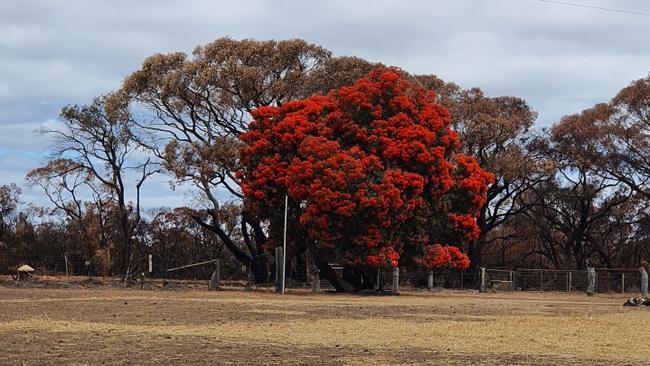
The tree’s transcendent image, a stark depiction of resilience against all odds, has come to represent all that Kangaroo Island’s western community is known for. In the wake of the unprecedented bushfire disaster of 2019-20 – which consumed half the island, destroyed more than 100 houses, killed two people and more than 50,000 sheep – the recovery became another battle to be fought and won by the determined farmers whose livelihoods had been so cruelly razed.
This land and its people are instilled with the spirit of war veterans whose penchant for hard work and determination against all odds will remain forever unmatched.
The pioneering perseverance of the island’s soldier settlers is the stuff of legend. Yet few know their history, let alone celebrate it. Now their story is set to be told in a new one-hour documentary Fighting to Farm, which will premiere on Foxtel’s History Channel tomorrow.
Only three of the original soldier settlers remain alive today. It is apt that Dudley Roberts, 97, and Des Johnston, 95, still live on Kangaroo Island because, as Des notes wryly, “why would you leave?”
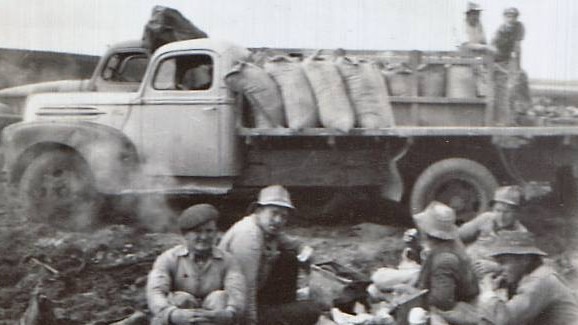
The term soldier settler was given to men offered land to farm as part of a federal government repatriation scheme for returned WWII veterans. The work program was run in rural locations around Australia but Kangaroo Island’s version was unique in multiple ways, becoming the nation’s largest such scheme in terms of land mass.
Due to its high rainfall, the island had been identified as a prime location for new production land but for the young families who first arrived in 1948 in search of a new life, it was more unnerving than liberating. Most knew nothing about the island and were unprepared for the primitive conditions they would face on arrival.
“I travelled to Kingscote by boat in 1950 and we immediately got piled into the back of a truck to travel out to the camp,” navy veteran Des recalls with a grin.
“There weren’t any roads to the west of the island back then, just tracks. Our accommodation was just an army camp that had been brought over. A family lived in each end of the rows of flats. They weren’t very flash but I suppose everyone put up with it. If you wanted to stay here you had to put up with it.”
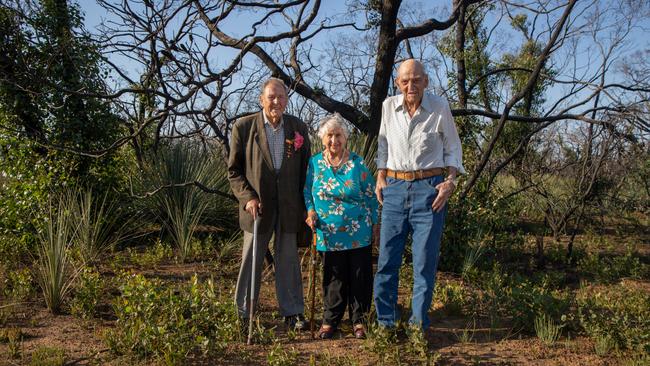
It must have been an ironic realisation. Having survived the harsh conditions of war these men were thrust back into an army camp in the middle of vast virgin scrub at the untamed heart of the island. Ivy and her late husband Tom, who had left their comfortable life in Burra, were shocked to the point of regret.
“We’d never been to the island before and we didn’t know what we were coming into,” she says. “When we arrived at the camp we thought, ‘oh my god what have we done?’ It was very, very rough. We had no power, no water laid on anywhere but there was a community of people that helped each other – everyone got on well. We lived there for just over two years but some of the people before us had been in there up to four or five years.”
The long wait was necessary in the early days of the scheme for one important reason: there was no land to plough. Every square metre of the allocated farming region needed to be clear-felled by the ex-soldiers, mostly through the use of pairs of tractors that pulled massive logs between them on chains. Des spent almost three years in the wilderness flattening thick scrub, a gruelling and painstaking task.

“It wasn’t a very good life,” he says. “You look back now and people wouldn’t realise that we camped in a bag tent in the middle of winter. We spent most of our time wet with no protection from the rain. You had to try and cook your meal at night time on an open fire. It was a big job – there would have been a hundred tractors here.”
“I suppose most of the lads that came over here were all reasonably young and fit as a fiddle having come out of the Services. They didn’t take any notice of the hardship. There wasn’t any point in taking notice of it. You still had to do it!”
Over the course of the next 14 years, the men cleared over a quarter of a million acres without a death or serious injury. Despite this feat of human endurance, the hard work had only just begun. Army veteran Dudley Roberts remembers how difficult it was to get the new farms into working condition.
“It was all pretty hard going once you got on your own,” he says. “When we came over here they said, ‘You’re going to plough this paddock’; well, there were sticks and stones everywhere! I’d never seen anything quite like it. It was as rough as guts over here but we were going to make a farm of it eventually.”
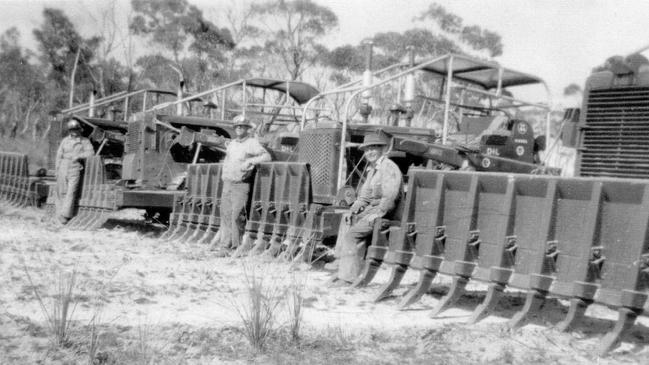
Dudley scoffs at any thought of giving up on a challenge. He’d been shot at by Japanese snipers in the jungles of New Guinea and Borneo – he wasn’t going to be beaten by a bit of rocky ground.
It was with this sense of ingrained determination that the farmers and their families approached all the problems of their new life; a £30,000 debt to the government, kilometres of fencing that needed to be built by hand, the bottoming out of the sheep market, a devastating clover disease that killed lambs, the threat of foreclosure. The list goes on.
It was only through the support of their colleagues that the scheme survived and then thrived. Small communities in the west of the island were formed by volunteers who built local halls at Stokes Bay, Gosse, Karatta and Birchmore, while the central town of Parndana continued its steady growth. Regular dances, balls, fundraisers, barbecues and a variety of sports were held at these halls that became vital gathering places for women escaping the isolation of their farms and men seeking solace from recurring war memories with their fellow Diggers.
It was why the 2019-20 fires were so heartbreaking for so many. Both the Gosse and Stokes Bay halls were gutted in the firestorm. Ivy was particularly hurt by the loss of Gosse Hall, home of the Western Districts Community & Sporting Club.
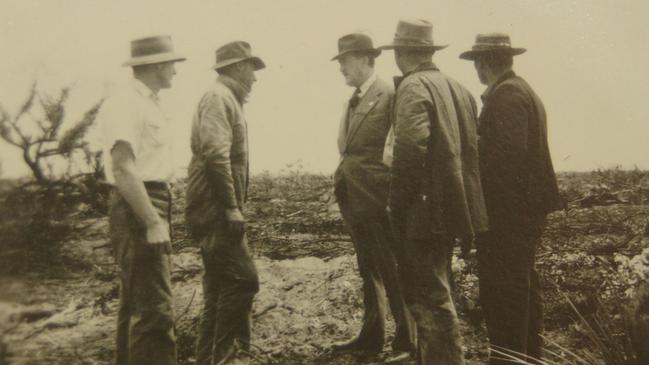
“Seeing the heap of rubble was something that really upset me,” she says.
“It broke my heart because I knew the work that had gone into building that hall. We raised all the money to build it as a community and it was wonderful when it was opened.”
Thankfully, rebuilds have begun at both halls, with close to $900,000 secured from the KI Mayoral Relief and Recovery Bushfire Fund. Across the west of the island, where most of the original soldier settler farms and houses were wiped out, new homes and sheds have begun to appear where charred remains once stood. There is a sense that a new beginning has arrived but locals are determined that the history of the area never be forgotten.
The house that Dudley lived in during his days ploughing the land at Gosse was destroyed in the fire and his farming grandsons suffered stock, shed and home losses. “Seeing my old house burnt down didn’t make me feel real good,” Dudley says. “But it’s important these farms continue on. People are rebuilding, they had good rains last year and the grass came back. There are a lot of kids coming through and there’s unfinished business.”
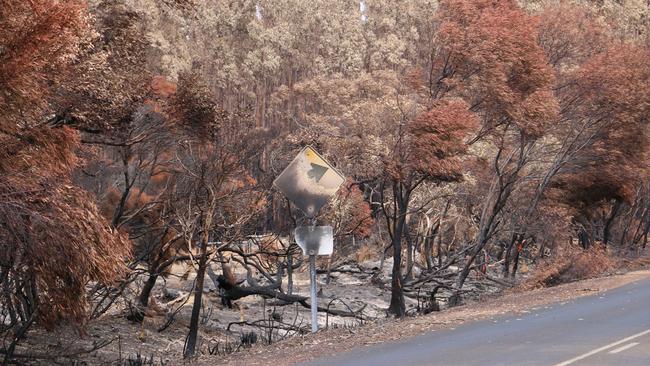
It’s a testament to the strength of the region’s character that many of the original soldier settler farms are being run by the sons, daughters and grandchildren of their pioneering forefathers. The Parndana Soldier Settlement Museum, which houses photos, memorabilia, and old farming machinery, has grown in significance since the disaster.
“I think the spirit of the soldier settlers still lives here today,” Des says. “I notice it in the community, at the sport. It means a lot to these young fellas around here.”
Des – who still lives in Parndana with his wife Rita – knows a thing or two about survival and loss. He enlisted in the war when he was 17 and returned to Australia a veteran at the age of 19. His multiple Kangaroo Island farms were burnt twice over the years. “I know very well what some of these guys have had to go through over the past year or so,” he says. “To lose those sheep breeding lines can mean it’s a long way back but you just have to remember to get the handkerchief out, wipe the tears away and get stuck into it.

“When I got burnt out twice I had to do about 40 or 50kms of fencing on my own. When there is a big fire everyone comes to help. When it’s a small fire you’re left on your own. I would have done anything back then for the $75,000 that the victims receive nowadays. It’s good they’ve been looked after but a lot of people have still found it pretty hard – there’s been a lot of suffering.”
After all that the island community has been through in the past 16 months, tomorrow’s Anzac Day will hold special significance for the surviving settlers and their families.
“Over the years I’ve been here it’s amazing how the younger people have come to recognise Anzac,” Des says. “You go to the events now and it’s really crowded and the majority of people are young. I remember those boys that died in the war and I think, that’s 70 years of their life they lost. It’s bloody sad.”
One of the most symbolic elements of the fire recovery was the emergency assistance provided to the region by army reservists who spent weeks on the island helping out by completing tasks such as fencing, clearing debris and burying stock. The poignant symbolism of modern-day servicemen helping the descendants of WWII heroes was not lost on Des.
“They were magic those lads. Even after spending all day getting dirty and carting stinking dead sheep, they all still had smiles on their faces and were really polite. I put a big notice in the window of the shop on the main street saying what a wonderful example it was for these young fellas to be representing the army in Australia. Most of them knew the soldier settler story as well.”
Fighting to Farm will screen on Foxtel’s History Channel tomorrow at 7.30pm




